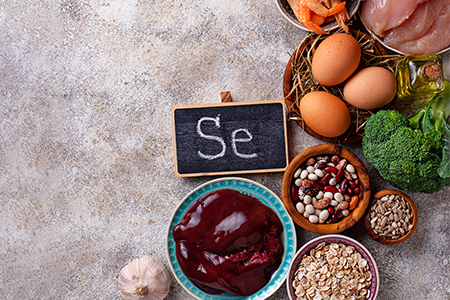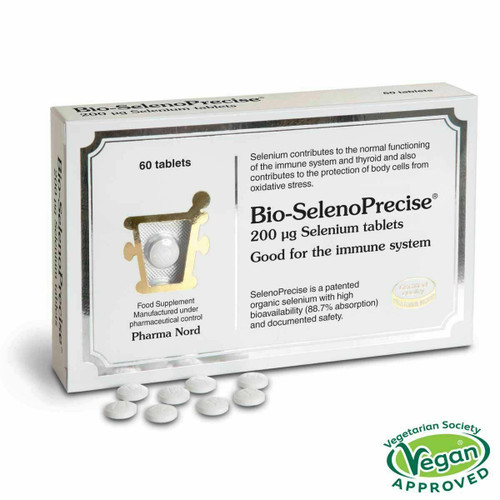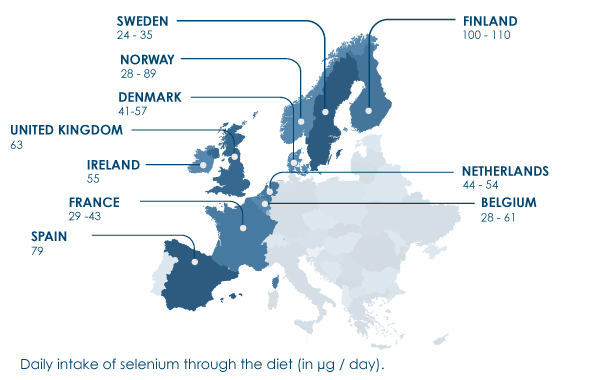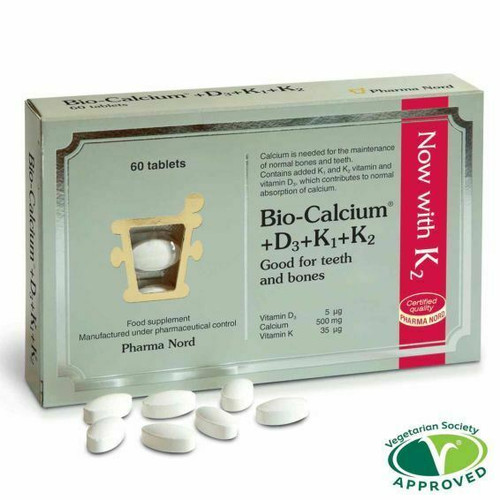Bio-SelenoPrecise 100mg 60 Tablets Pharma Nord
Bio-SelenoPrecise are small, round white tablets each containing 200 micrograms of selenium from Pharma Nord's patented, standardized selenium yeast. SelenoPrecise contains in addition to selenomethionine more than 20 other organic selenium compounds. SelenoPrecise stands out by being able to document a very high level of bio-availability and a stable quality:
- 15 laboratories in 12 different countries have measured the content of L-methionine selenium in SelenoPrecise to be high and stable
- 89% of the selenium content is absorbed in the body
Why so many different selenium compounds?
Bio-SelenoPrecise contains many different selenium compounds because each type of selenium has different functions in the human body. By supplying a wide spectrum of selenium compounds it is possible to emulate the natural variety of selenium types found in selenium rich food. This, scientists believe, has the best effect on our health.
Selenium is an essential trace element (mineral) of fundamental importance to human health
What is Selenium?
Selenium is an essential trace element that supports an array of selenoproteins and selenium-dependent enzymes that are important for human health and well-being. One of these enzymes is glutathione peroxidase (GSH-Px), which has several important functions in the body. In addition, selenium supports a normal thyroid function. The thyroid function helps the metabolism in balance. Furthermore selenium supports biological processes as:
- a normal immune system
- production of normal sperm cells
- cell protection
- the maintenance of normal hair and nails
Most of the selenium in the body is found in two forms:
Selenomethionine (that is embedded in different proteins instead of methionine) and selenocysteine.
We get selenomethionine from the diet exclusively because the body is unable to synthesize it. The body is, however, able to convert selenomethionine to selenocysteine, which we are also able to get from the diet in the form of se-methylselenocysteine.
In situations where we get too little dietary selenium, the body is able to use selenium that is stored in the body, simply by converting selenomethionine that is bound in different proteins.
Bio-SelenoPrecise contains both of these main selenium sources (selenomethionine and selenocysteine) plus several other selenium compounds.
The ability of selenium to bind to heavy metals
In the body, selenium binds to different heavy metals and forms insoluble compounds that are eventually discharged from the body. This process consumes some of the available selenium, leaving less for other important selenium-dependent processes*. Studies show that selenium binds mercury in a 1:1 ratio.
* Schrauzer GN Selenium and selenium-antagonistic elements in nutritional cancer prevention. Crit Rev Biotechnol. 2009;29(1):10-7.
 Where do we get selenium from the diet?
Where do we get selenium from the diet?
Selenium is found in such things as fish, nuts, whole-grain. People who do not consume these food items regularly may benefit from taking a selenium supplement for the sake of getting sufficient amounts of the nutrient. The recommended daily allowance (RDA) for selenium is around 50-70 μg (differs from country to country), were men generally need a little more than women.
Organically bound selenium has higher absorption
Selenium in the agricultural soil is inorganic. Once it gets absorbed by plants (and ends up in animals) it gets converted to organic selenium. The selenium we get from our diet can be bound to amino acids such as methionine and cysteine. In contrast, selenium in supplements can either be organic or inorganic. It is known that organic selenium compounds have an easier time getting absorbed into the body and incorporated in the different selenium-dependent enzymes and selenoproteins.
The selenium content in agricultural soil differs
In countries where the agricultural soil is rich in selenium the population has a correspondingly high selenium intake. In the United States where there is a high selenium content in the soil (especially in the northern regions), the average selenium intake is around 60-220 μg daily.
Most soils in the UK and Europe are deficient in selenium, which translates in low-selenium of farmed food and eventually, low selenium status of populations who consume local food. When the figures for Finland are not too low, it is due to the country's selenium enrichment of fertilizers.
Selenium is not just selenium
Selenium is an element and a mineral found in the soil in varying amounts. In countries such as the United States, the agricultural land has a fairly high content of selenium, while it is relatively low in most European countries. Grain and other plants absorb selenium from the soil. Therefore, the diet's selenium content largely depends on the amount of selenium found in the agricultural land.
Organic and inorganic selenium
It is important to be aware that there are different types of selenium when selecting a selenium supplement.
Inorganic selenium
In selenium supplements, inorganic selenium is often used in the form of simple selenium salts. It might be sodium selenite and sodium selenate. Selenium is usually insoluble in water, but selenium in the form of selenite and selenate is soluble in water. A little over half of these two inorganic selenium salts are absorbed into the body, selenite slightly better than selenate, however, they are also excreted quite quickly, which limits their usefulness.
Organic selenium
Plants absorb inorganic selenium from the soil in the form of selenate. When the selenium hereafter is incorporated into the plants as selenomethionine and, to a lesser extent, selenocysteine, it becomes organic selenium. The organic selenium compound L-selenomethionine - i.e. the selenium attached to the amino acid methionine - can also be manufactured synthetically. Synthetic L-selenomethionine is widely used as organic cell supplement and is one of the most studied selenium compounds.
From animal food we primarily get selenium in the form of selenocysteine.
Selenium yeast
Selenium yeast originate from yeast cells which are grown in a selenium-containing nutrient substrate. It provides a high content of naturally occurring organic L-selenomethionine. The selenium yeast also contains methylselenocysteine as well as a variety of other organic selenium compounds that emulate the natural selenium variants found in the diet and, according to scientific studies, are important. The selenium yeast is subsequently inactivated by heat and made into a powder after which it functions as a selenium and protein rich nutrient.
Also difference in selenium yeast
There is also a difference between the quality of different yeast products. A non-standardized yeast is typically exposed to relatively large variations in the nature and amount of the various selenium compounds. This means that their absorbability can vary a lot. The yeast products that show the best properties are made as pharmaceutical grade and have a very small variation in type and amount of its various selenium compounds.
SelenoPrecise as an Active Pharmaceutical Ingredient
Today, Pharma Nord is the only manufacturer in the world that has an approval to produce organic medical grade selenium yeast. This completely unique, patented medical raw material is used in Denmark under the names SelenoPrecise, where the indication is prevention and treatment of selenium deficiency. All Pharma Nord's dietary supplements with selenium contain this original selenium yeast, SelenoPrecise.
SelenoPrecise API (Active Pharmaceutical Ingredient)
SelenoPrecise (and Bio-SelenoPrecise) contains many different species of selenium, each of which has been shown to have different functions in our body. By supplying the body with a wide range of selenium species, it is possible to emulate the natural selenium variation found in a versatile diet. This means that the different selenium compounds can follow different biological pathways in the body and remain in the blood for varying periods of time. This is believed to have the greatest health benefit. Among the advantages of organically bound selenium species from selenium yeast are a higher absorption and bioavailability than from both inorganic selenium forms and synthetically produced selenomethionine.
The challenge: homogeneity
Production of homogeneous selenium yeast tablets, i.e. tablets that are similar from production batch to production batch, so that they qualify for use as a medicine, is a difficult task. There are several reasons, not least that the tolerance requirements are so small. Thus, the permissible quantity deviation from the declared amount of selenium is very small, and at the same time, the content of the raw material of the different selenium forms must be similar from production to production. It makes sense, because of course you have to be able to count on being able to get the same effect from every single tablet.
Pharma Nord's selenium yeast contains more than 20 different selenium species, the content of organic selenium methionine selenomethionine is stable at 67%, and the proportion of inorganic selenium will not exceed 1% of the total amount of selenium.
Selenium compounds in SelenoPrecise
In analytical studies of SelenoPrecise selenium yeast, these selenium compounds have been identified:
Selenomethionine, selenomethionine selenium oxide (SeOMet), selenocysteine-se-methylselenocysteine, trimethylselenonium, selenomethylselenocysteine, selenomethylselenomethionine, gamma-glutamyl-se-methylselenocysteine, selenocysteine and polypeptides or low-molecular-celled polypeptides. In particular, the important selenocysteine-se-methylselenocysteine compounds, which are found in high amounts in garlic and which are considered to have a special protective effect, are optimized in SelenoPrecise compared to other selenium preparations.
Production of selenium yeast
Pharma Nord's selenium yeast is produced by fermentation. Live yeast cells (non-GMO) are "fed" ammonia as well as glucose, vitamins, minerals and inorganic selenium of pharmaceutical quality. The yeast cells will then incorporate and integrate the selenium into their cell walls and become part of the proteins in the yeast cells. In this way, the inorganic selenium has been changed to natural, organic selenium yeast.
The selenium yeast is then pasteurized, whereby the yeast cells die. The selenium-containing yeast cells are centrifuged, washed, frozen, pulverized, spray-dried, and compressed into tablets.
Summary
There are distinct advantages to taking API selenium yeast compared to taking other selenium forms.
- It is organic. The selenium content stays and acts longer in the body than inorganic selenium before it is excreted.
- It contains more than 20 different selenium compounds found in nature in a selenium-rich diet.
- It has a very small variation in the amount of its various selenium compounds.
- You get the same effect from tablet to tablet as with medical preparations.
- It has given the best results in scientific studies.
* EP Patent No. 1 478 732 B1.
EU's Best-Documented Selenium Product
Scientifically Documented
See related categories
- Heart Health
- Immune System
- Men's Health
- Minerals
- Vegan
- Vegetarian
SelenoPrecise in research








